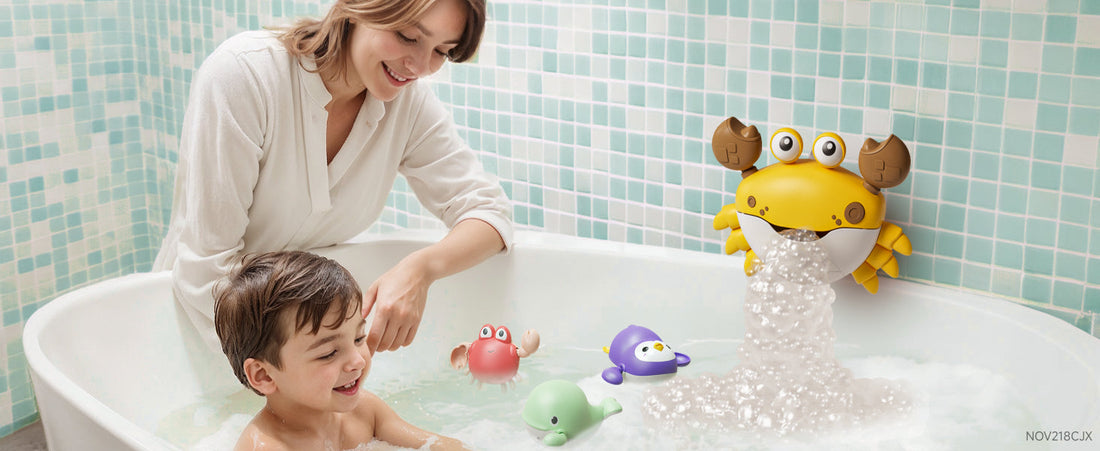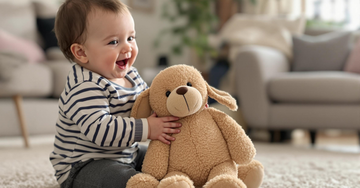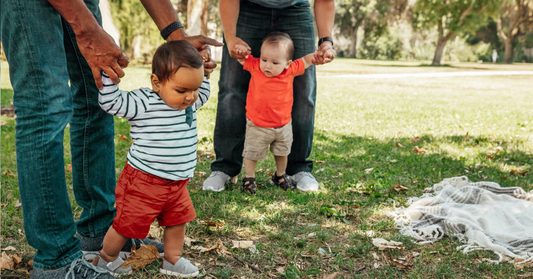목욕 장난감을 소독하는 방법: 전문가가 승인한 안전하고 깨끗한 4가지 방법

목욕은 단순한 정화 의식이 아니라 부모와 자녀에게 중요한 유대감을 형성하는 경험입니다. 그러나 "Biofilms and Microbiomes" 저널에 발표된 한 연구에 따르면 우려스러운 현실이 드러났습니다. 목욕 장난감은 잠재적으로 병원성 박테리아, 곰팡이, 심지어 대변 대장균을 보유할 수 있습니다. 콜로라도 소아 병원의 소아 감염병 전문의인 리사 화이트헤드 박사는 "욕조 장난감 내부의 습하고 따뜻한 환경은 어린이의 건강 위험을 초래할 수 있는 미생물의 이상적인 번식지를 만듭니다."라고 경고합니다.
이 놀라운 발견으로 인해 많은 부모가 다음과 같은 질문을 던집니다. 목욕 장난감을 효과적으로 세척하고 소독하려면 어떻게 해야 할까요? 이 포괄적인 가이드는 자녀의 목욕 환경이 즐겁고 안전하게 유지되도록 하는 증거 기반 방법을 제공합니다.
목욕 장난감 소독의 중요성
특정 세척 기술을 살펴보기 전에 이 작업이 왜 그렇게 중요한지 이해하는 것이 중요합니다.
- 곰팡이 예방 : NYU 의대의 미생물학 및 병리학 임상 교수인 필립 티에르노 박사는 "곰팡이는 습한 환경에서 24~48시간 이내에 자랄 수 있습니다. 흡입하거나 섭취하면 특정 곰팡이가 알레르기 반응이나 호흡기 문제를 일으킬 수 있으며, 특히 면역 체계가 약한 어린이에게 그렇습니다."라고 설명합니다.
- 박테리아 제거 : "Journal of Applied Microbiology"에 게재된 연구에 따르면 목욕 장난감에는 제곱센티미터당 최대 7,500만 개의 박테리아가 포함될 수 있다고 합니다. 노스웨스턴 대학교 환경 공학 조교수인 에리카 하트만 박사는 "모든 박테리아가 해로운 것은 아니지만, 목욕 장난감에서 발견되는 일부 종(예: 녹농균)은 어린이에게 귀 감염과 피부 발진을 일으킬 수 있습니다."라고 말합니다.
- 위생 유지 관리 : 질병통제예방센터(CDC)는 감염 확산을 예방하기 위해 목욕 장난감을 정기적으로 세척하고 소독하는 것의 중요성을 강조합니다. 존스홉킨스 보건안보센터의 수석 학자 아메시 A. 아달자 박사는 "목욕 장난감의 적절한 위생을 유지하는 것은 전반적인 가정 위생의 필수적인 부분이며, 아동 감염 위험을 크게 줄일 수 있습니다."라고 말합니다.
목욕 장난감을 소독하는 효과적인 방법
- 식초 용액
애리조나 대학의 미생물학자이자 교수인 찰스 게르바 박사는 식초를 천연 살균제로 추천합니다. 백식초는 아세트산 함량으로 인해 많은 종류의 박테리아와 곰팡이에 효과적입니다.
- 큰 그릇에 식초와 따뜻한 물을 같은 양으로 섞어 놓습니다.
- 목욕 장난감을 이 용액에 최소 15분 동안 담가두세요.
- 눈에 보이는 먼지나 곰팡이를 제거하려면 솔로 문지릅니다.
- 깨끗한 물로 깨끗이 헹군 후 자연 건조하세요.
- 표백제 솔루션
효과적인 살균제로 희석된 표백제. 그러나 어린이 용품 주변에서 표백제를 사용할 때는 주의가 필요합니다.
- 물 1갤런에 표백제 1/2컵을 섞습니다.
- 장난감을 이 용액에 5~10분 정도 담가두세요.
- 깨끗한 물로 깨끗이 헹구세요.
- 다음 사용하기 전까지 장난감을 완전히 자연 건조시키세요.
- 잔류 화학 물질 노출을 방지하기 위해 표백제 용액을 사용한 후에는 장난감을 항상 잘 헹구십시오.
- 식기 세척기 방법
식기 세척기 세척이 가능한 장난감의 경우, 고온은 효과적으로 살균할 수 있습니다. 식품의약국(FDA)은 최소 150°F(65.6°C)의 물 온도가 살균에 효과적이라고 말합니다.
- 장난감은 식기 세척기 위쪽 선반에 놓으세요.
- 세제를 사용하지 않고 뜨거운 물로 세탁을 진행하세요.
- 세척이 끝나면 장난감을 즉시 치우고 자연 건조하세요.
- 끓는 물
이 방법은 작고 전자적이지 않은 플라스틱 장난감을 위한 것입니다. 그는 "끓는 물은 대부분의 해로운 박테리아와 바이러스를 몇 분 안에 죽일 수 있습니다."라고 말합니다.
- 물이 담긴 냄비를 강하게 끓입니다.
- 장난감을 조심스럽게 물에 넣고 5~10분간 끓입니다.
- 집게로 꺼내어 식힌 후 공기 건조시킵니다.
예방 팁: 목욕 장난감을 깨끗하게 유지하세요
목욕 장난감을 소독하는 방법을 아는 것이 중요하지만, 예방도 마찬가지로 중요합니다. Children's Mercy Kansas City의 감염병 책임자인 Mary Anne Jackson 박사는 다음과 같은 팁을 제공합니다.
- 물을 짜내다 : 사용 후에는 장난감 안에 갇힌 물을 짜내세요.
- 적절하게 보관하세요 : 장난감은 통풍이 좋은 용기나 메쉬백에 넣어서 건조를 촉진하세요.
- 정기점검 : 장난감에 곰팡이나 손상 흔적이 있는지 정기적으로 확인하세요.
- 장난감을 회전시키다 : 모든 장난감을 한꺼번에 욕조에 넣어 두는 것을 기다리세요. 장난감을 돌려서 완전히 말리세요.
목욕 장난감을 교체해야 할 때
정기적으로 세척하더라도 목욕 장난감은 영원히 지속되지 않습니다. 소아과 의사이자 작가인 제니퍼 슈 박사는 다음과 같은 경우 장난감을 교체할 것을 권장합니다.
- 그들은 물이 갇힐 수 있는 구멍을 개발합니다.
- 세척으로 없어지지 않는 곰팡이가 꾸준히 자라고 있습니다.
- 장난감이 손상 또는 마모되어 해로울 수 있는 흔적을 보입니다.
목욕 장난감 위생에 있어서 재료의 역할
아동 안전 제품을 전문으로 하는 재료 과학자인 페트라 암브로시아 박사는 더 안전한 목욕 장난감을 선택하는 방법에 대한 통찰력을 제공합니다. "실리콘이나 특정 단단한 플라스틱과 같은 비다공성 재료로 만든 장난감을 선택하세요. 이러한 재료는 박테리아를 보유할 가능성이 적고 종종 철저히 세척하기가 더 쉽습니다."
결론
깨끗한 목욕 장난감을 유지하는 것은 어린이의 안전하고 건강한 목욕 일상을 보장하는 데 중요한 측면입니다. 목욕 장난감을 정기적으로 소독하고 적절한 보관과 시기적절한 교체를 결합하면 감염 위험을 크게 줄이고 더 안전한 목욕 환경을 조성할 수 있습니다.
전문가가 권장하는 목욕 장난감 소독 방법을 구현함으로써 부모는 자녀에게 안전하고 위생적이며 즐거운 목욕 시간을 보장할 수 있습니다. 일관된 세척 관행과 장난감 상태에 대한 세심한 모니터링은 건강한 목욕 환경을 유지하는 데 중요합니다. 이러한 전략을 적용하면 자녀에게 깨끗하고 즐거운 목욕 경험을 자신 있게 제공할 수 있습니다.
당사의 전체 범위를 살펴보세요 아기와 유아용 목욕 장난감 목욕시간을 즐겁게 보내세요!







0 댓글